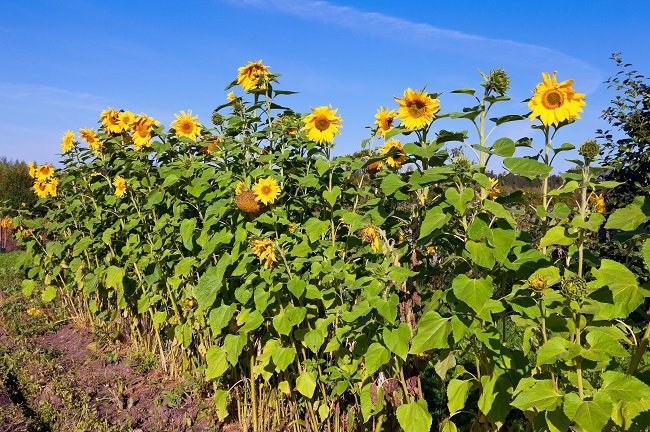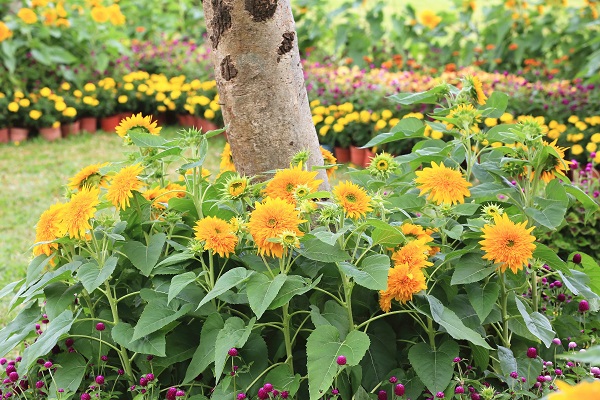
The sunflower is one of the most widely recognized flowers. This large flower blooms in a wide variety of yellows, pinks and even reds. With a little care you will be rewarded by the most noble of garden beauties. The many varieties have something to offer gardeners of any age regardless of space limitations.
Selecting a Growing Location
The following items need to be considered while choosing where to grow sunflowers.
Sun and Wind Exposure
As the name implies, sunflowers like the sun and do best when they are in a sunny location. A general guideline is to pick a spot that receives at least 6 hours of sunlight daily. If they are planted in a shady area, sunflowers may stretch to reach sun and will require additional staking support. This will also be true if they are planted in a windy area. Consider planting tall varieties on a fence line to help with support.
Orientation to Other Plants
Tall varieties block sun and wind from your other garden plants. This can be a good thing if you are trying to shelter plants from too much sun or wind, but you must also consider if the sunflowers are going to negatively impact other sun loving plants. Sunflowers will face east at maturity, and this should be considered in their placement as well.
Days to Maturity
Most sunflower varieties have a maturity between 75 and 110 days. The nice thing is that you can grow them from the last freeze until winter sets in again. Consider planting a few each week to insure staggered blooms and enjoyment throughout the growing season. Stop planting 75-100 days before the first winter freeze is expected in your location.

Annual or Perennial Varieties
Most people plant annual sunflowers, but if you only plant annuals you are missing out on some beautiful long-term varieties. Perennials may take one to three seasons to begin producing blooms, but they are well worth the wait and can be great producers of flowers for years to come.
Color Coordination for the Garden
Most people are familiar with the classic giant sunflower that has one large yellow flower with a dark center. Fortunately for sunflower lovers, there are many different colors and varieties to choose from. Vincent Van Gogh loved sunflowers for this reason. Take the time to select and place different size and color varieties in the landscape. Some gardeners like to use larger varieties as the backdrop and progress to mid sized and then small varieties as they get closer to the house or other public sitting areas.
Plant Size and Spacing
Following the recommendations for spacing typically leads to the healthiest and most successful plants and should dictate how many plants are located a given area. Pay close attention to the spaces you intend to fill when you are selecting which varieties to plant.
Containers, Planter Beds or Open Space
With the increasing popularity and development of dwarf varieties more sunflowers are being planted in containers than ever before. Using containers smaller than six inches is not recommended, because even if the plants can tolerate them, they dry out too quickly. If you are planting in medium or large pots that are eight inches and larger, you can slightly bend the rules for suggested spacing for the variety and plant three individual plants in each pot. It is still better to stick with small varieties (less than three feet) for medium pots and small or medium (three to five foot) varieties for large pots. It is critical that your containers have drainage holes. Sunflowers need well drained soil.
The Pollen Factor
Most people do not have problems with the pollen from sunflower gardens. If you or someone you know is particularly sensitive to pollen, you are in luck. Many varieties of sunflower are pollen free.
Intended Use
Consider if you would like to have a steady supply of cut flowers from your plants. Some varieties are particularly good for long lasting cut flowers. With flower preservatives in the water and weekly water changes some varieties can last for several weeks. Birds are particularly fond of the seeds produced by some varieties and butterflies are attracted by others. Sunflowers have myriad of uses; in the garden the stocks of large varieties can be dried and tied together to form rustic trellises for other plants and they make good poles to help support plants including future generations of sunflowers.
Soil and Weather Conditions
Most sunflowers do best when they are transplanted in adequately prepared soil, but some varieties of are particularly good in poor soil conditions. Other varieties are particularly strong for extra hot conditions and periods of dry soil. If your plants will be in a windy area, consider bushy, branching varieties and/or be prepared to stake them.
Starting From Seed
If you decide to start your sunflowers from seed you will have several methods to consider each of which has advantages and disadvantages.
Direct Seed Method
Sunflower seeds can be sowed directly in the garden or containers, and in some instances, this may be a viable choice. One problem is that seeds and small plants are much more susceptible to falling victim to pests and predators than even two- or three-week-old transplants. In many areas the birds or rodents will dig up the seeds before they even get a chance to sprout. Care can be more difficult because seeds and sprouts must be kept moist and not be allowed to dry out. One other possible disadvantage is that there are always some seeds that never become viable sunflower plants. It can be easier using transplants that have already been selected as strong prospects. It is also normally easier to germinate the seeds before transplanting them into the garden or containers.
Using Professional Seed Starting Trays
Some people prefer to start many seeds at the same time in professional seed starting trays which are a plastic tray with separate compartments for each plant and a drip pan. This method allows you to start as many as three dozen seeds at one time. It also allows for removing any weak plants and leaving only healthier sprouts that can be transplanted to the garden where they will face harsher elements and predators. With this method you will want to use a potting mix that is specifically designed for starting seeds. These mixes are finer than even premium potting mixes and contain all the nutrition that sprouts need to make it through the first two or three weeks. This method is certainly acceptable, but it too has some draw backs. There is a chance even if you are careful when transplanting the plants from the container that you will damage the root system and stress the young transplant.
Starting with Peat Pots or Pellets
Peat pots are small pots made of pressed peat moss. They can be filled with seed starting mix and planted in the garden when the transplants are ready, but there is an even easier alternative. Peat pellets are an ingenious innovation that consists of a compressed peat wafer inside a biodegradable mesh case. When the pellet is soaked in water it swells to five times its size and makes the ideal starting medium for the seeds. Simply push a seed or two in the top of each soaked pellet, place them near a sunny window and keep them moist. You can even buy these with plastic trays that have clear lids on them and act as mini-greenhouses for sprouting seeds. The lids reduce or even eliminate the need to add additional water to the pellets until after the seeds sprout. Once the seeds sprout just remove the lid and continue to water the sprouts until they form their second set of real leaves, generally two to three weeks. The bags can then be transplanted to the growing area.
Transplanting to the Garden or Containers
Transplanting is an exciting time. It is when the young plants that have germinated from seed are placed into the garden or a container. There are a few important considerations as you begin this phase of your sunflower adventure.
Spacing Considerations
New gardeners seem to be particularly prone to overcrowding their plants. Whether this is caused by a desire to not sacrifice any weak stragglers, or a desire to get as many plants in each area as possible it is a serious mistake that will hamper growing quality plants. Select only the strongest young plants to include in the garden. As a rule the seeds that germinate first tend to grow faster and produce stronger plants. By being picky and selecting only the top 50% of sprouts to transplant you will be helping ensure a strong crop. It is also extremely important to follow spacing guidelines that are specified on seed packets for each variety of plant. Failure to do so will result in less healthy, rangy plants that are struggling to compete with one another for food, water, sun, and root and air space.
Preparing Soil
Sunflowers can be grown in a wide variety of soil types and conditions. Regardless of the type or condition of the soil they are being transplanted into, it is a good idea to specially prepare the immediate area where each plant will be placed. A good recommendation is to dig a small six inch by six-inch hole for each plant. Fill this hole with specially prepared soil for each transplant, consisting of premium potting soil with time release fertilizer mixed in. Premium potting soil will either be labeled as such or will be one of the more expensive mixtures. With potting soil you generally get what you pay for. Do not use soil labeled as topsoil or garden soil; these blends compact too easily. The premium potting soil holds moisture and allows young plant root systems to develop quickly. The time release fertilizer will help feed the plants for up to four months and add extra insurance to the regular fertilizing schedule. If you prefer to grow plants organically, crab shell meal or fish pellets can be added to the soil instead of the time release fertilizer.
Caring for your Growing Plants
If the sunflowers have been started correctly, they will have a good foundation for growth, but they still need a regular feeding program. Plants require three main nutrients to be healthy: nitrogen which promotes healthy foliage, phosphorus which promotes flowers and potassium which is for strong roots and overall vigor. All fertilizer products list the ratios of these three components in the order given above. A label that reads 10-15-10 signifies that 10% of the contents is nitrogen, 15% is phosphorus and 10% is potassium. When the plants are in the growth stage before their flowers start to form you can promote healthy foliage growth by fertilizing every two weeks with a chemical or organic fertilizer that has a nutrient sequence of 20-10-10. Once the plants begin to form flowers switch to a bi-weekly fertilization product with a 10-20-10 ratio.
One Last Tip
Sunflowers are generally hardy plants, but pest problems can be reduced by spraying them with a mixture of ½ tablespoon of liquid dish detergent to one quart of water each week.
Dr. Christopher J. Kline is a master gardener and greenhouse owner that lives in Paradise Valley Arizona.
Related Articles & Free Email Newsletter Sign Up
7 Reasons for Companion Planting




Comment here